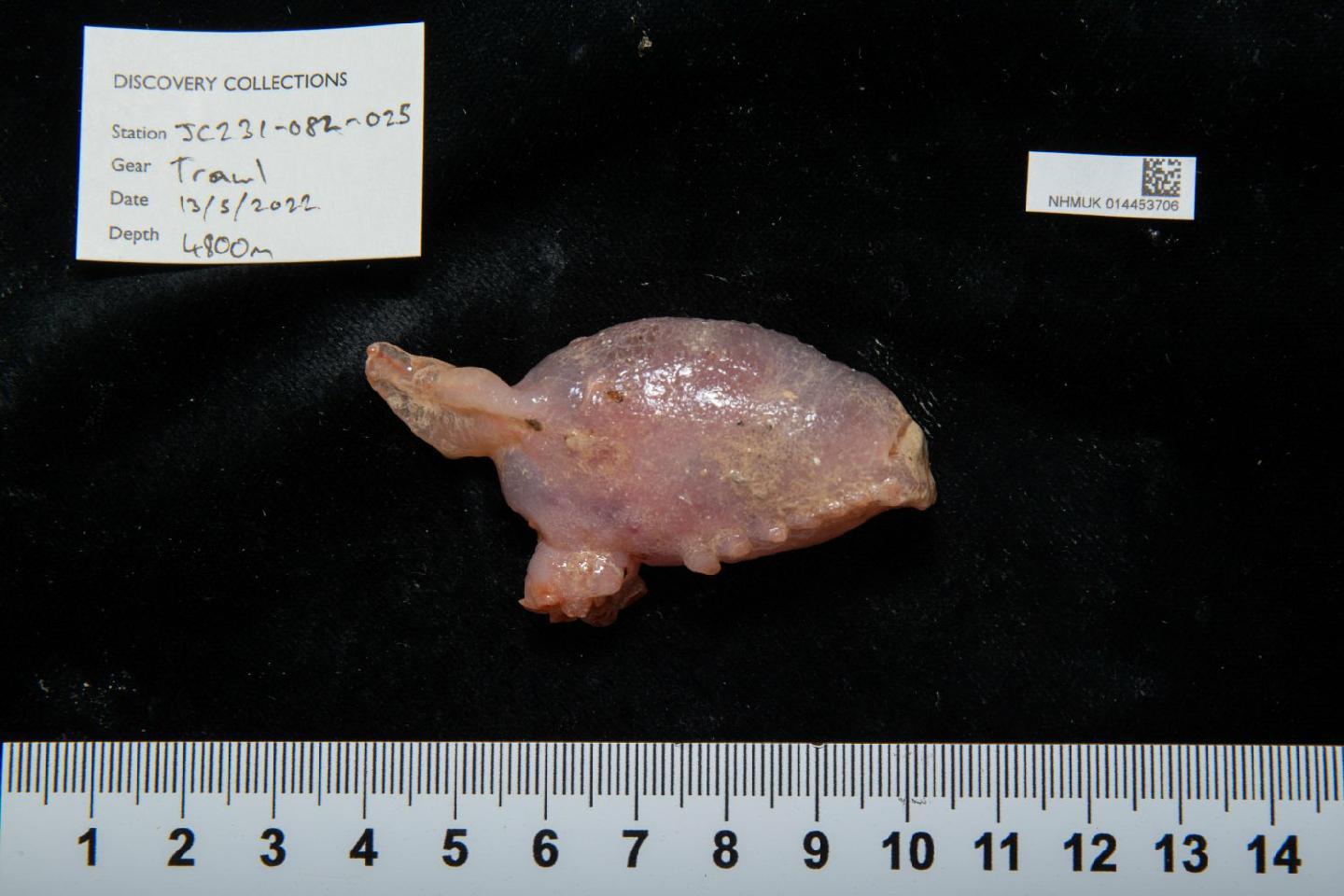WoRMS taxon details
Amperima rosea (E. Perrier, 1886)
124723 (urn:lsid:marinespecies.org:taxname:124723)
accepted
Species
Peniagone rosea E. Perrier, 1886 · unaccepted
Periamma roseum R. Perrier, 1896 · unaccepted (synonym)
marine, brackish, fresh, terrestrial
recent only
(of Peniagone rosea E. Perrier, 1886) Perrier, E. (1886). Les explorations sous-marines. <em>Librairie Hachette et Cie., Paris.</em> i-iv, 1-352. [details] 
WoRMS (2024). Amperima rosea (E. Perrier, 1886). Accessed at: https://marinespecies.org/aphia.php?p=taxdetails&id=124723 on 2024-11-21
Date
action
by
![]() The webpage text is licensed under a Creative Commons Attribution 4.0 License
The webpage text is licensed under a Creative Commons Attribution 4.0 License
original description
(of Periamma roseum R. Perrier, 1896) Perrier, R. (1896). Sur les Élasipodes recueillis par le <em>Travailleur</em> et le <em>Talisman</em>. <em>Comptes rendus hebdomadaires des séances de l'Académie des sciences.</em> 123(21): 900-903. [details] 
original description (of Peniagone rosea E. Perrier, 1886) Perrier, E. (1886). Les explorations sous-marines. <em>Librairie Hachette et Cie., Paris.</em> i-iv, 1-352. [details]
context source (Deepsea) Gebruk A.V., Smirnov A.V., Rogacheva A.V. (2014). Deep-sea fauna of European seas: An annotated species check-list of benthic invertebrates living deeper than 2000 m in the seas bordering Europe. Holothuroidea. <i>Invertebrate Zoology</i>. Vol.11. No.1: 156–180 [in English]. [details] Available for editors [request]
[request]
basis of record Hansson, H.G. (2001). Echinodermata, <B><I>in</I></B>: Costello, M.J. <i>et al.</i> (Ed.) (2001). <i>European register of marine species: a check-list of the marine species in Europe and a bibliography of guides to their identification. Collection Patrimoines Naturels,</i>. 50: pp. 336-351. (look up in IMIS) [details]
original description (of Peniagone rosea E. Perrier, 1886) Perrier, E. (1886). Les explorations sous-marines. <em>Librairie Hachette et Cie., Paris.</em> i-iv, 1-352. [details]
context source (Deepsea) Gebruk A.V., Smirnov A.V., Rogacheva A.V. (2014). Deep-sea fauna of European seas: An annotated species check-list of benthic invertebrates living deeper than 2000 m in the seas bordering Europe. Holothuroidea. <i>Invertebrate Zoology</i>. Vol.11. No.1: 156–180 [in English]. [details] Available for editors
basis of record Hansson, H.G. (2001). Echinodermata, <B><I>in</I></B>: Costello, M.J. <i>et al.</i> (Ed.) (2001). <i>European register of marine species: a check-list of the marine species in Europe and a bibliography of guides to their identification. Collection Patrimoines Naturels,</i>. 50: pp. 336-351. (look up in IMIS) [details]
 Present
Present  Present in aphia/obis/gbif/idigbio
Present in aphia/obis/gbif/idigbio  Inaccurate
Inaccurate  Introduced: alien
Introduced: alien  Containing type locality
Containing type locality
Unreviewed
Biology Abundance of these holothurians has increased dramatically - from around 4 individuals per ha (based on photographs) in the early 1990s to almost 6500 individuals per ha in the late 1990s (Bett et al., 2001). This phenomenon became known as the "Amperima event" (Billet et al, 2001). [details]
To Barcode of Life
To Biodiversity Heritage Library (1 publication) (from synonym Peniagone rosea E. Perrier, 1886)
To Biodiversity Heritage Library (6 publications) (from synonym Periamma roseum R. Perrier, 1896)
To European Nucleotide Archive, ENA (Amperima rosea)
To Genbank
To Genbank (from synonym Peniagone rosea E. Perrier, 1886)
To Genbank (from synonym Periamma roseum R. Perrier, 1896)
To NHMUK collection (Amperima rosea (E. Perrier, 1886); NON-TYPE; NHMUK:ecatalogue:9968910)
To PESI
To PESI (from synonym Periamma roseum R. Perrier, 1896)
To USNM Invertebrate Zoology Echinodermata Collection (3 records)
To ITIS
To Biodiversity Heritage Library (1 publication) (from synonym Peniagone rosea E. Perrier, 1886)
To Biodiversity Heritage Library (6 publications) (from synonym Periamma roseum R. Perrier, 1896)
To European Nucleotide Archive, ENA (Amperima rosea)
To Genbank
To Genbank (from synonym Peniagone rosea E. Perrier, 1886)
To Genbank (from synonym Periamma roseum R. Perrier, 1896)
To NHMUK collection (Amperima rosea (E. Perrier, 1886); NON-TYPE; NHMUK:ecatalogue:9968910)
To PESI
To PESI (from synonym Periamma roseum R. Perrier, 1896)
To USNM Invertebrate Zoology Echinodermata Collection (3 records)
To ITIS

